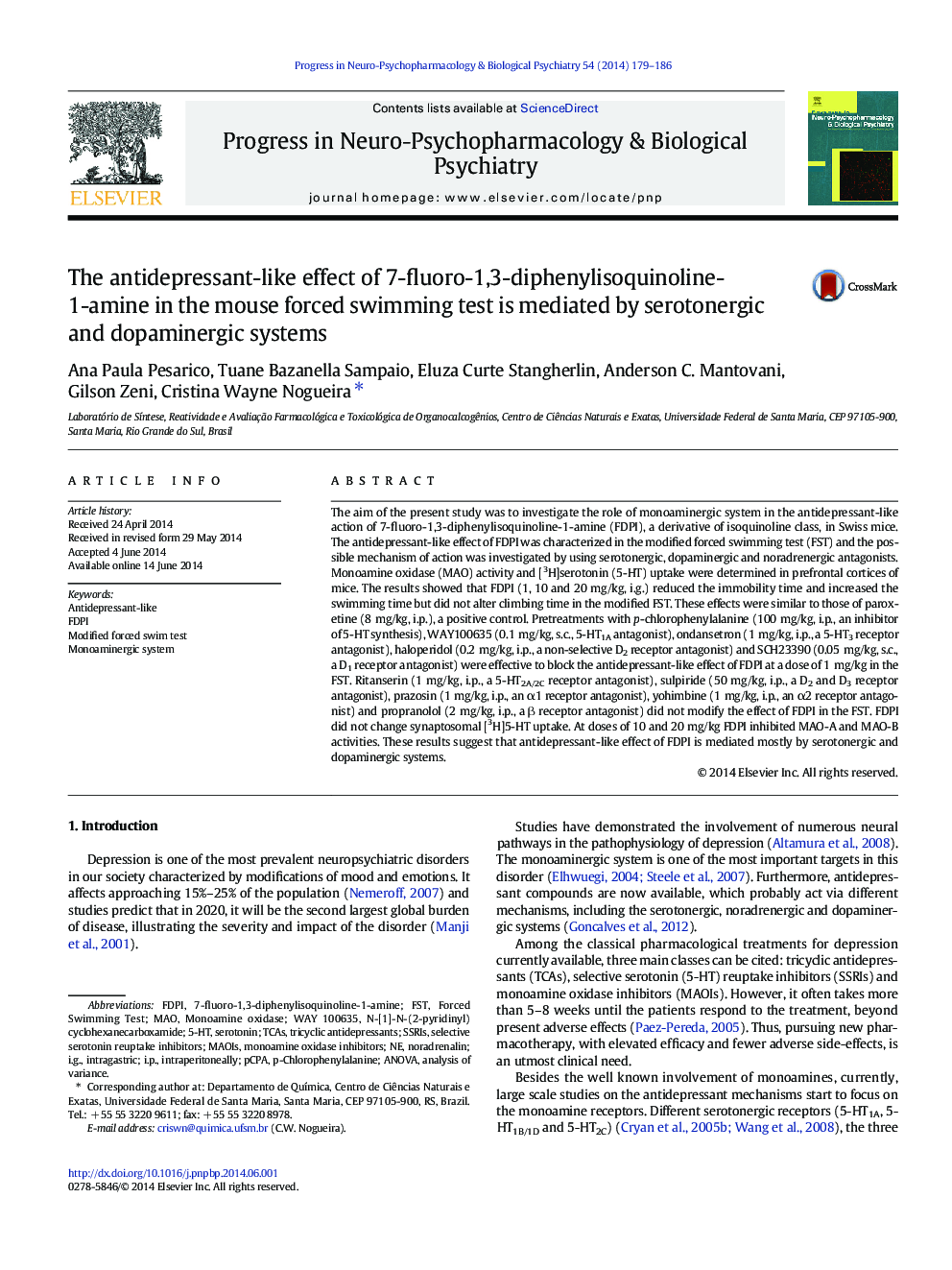| Article ID | Journal | Published Year | Pages | File Type |
|---|---|---|---|---|
| 5844330 | Progress in Neuro-Psychopharmacology and Biological Psychiatry | 2014 | 8 Pages |
Abstract
The aim of the present study was to investigate the role of monoaminergic system in the antidepressant-like action of 7-fluoro-1,3-diphenylisoquinoline-1-amine (FDPI), a derivative of isoquinoline class, in Swiss mice. The antidepressant-like effect of FDPI was characterized in the modified forced swimming test (FST) and the possible mechanism of action was investigated by using serotonergic, dopaminergic and noradrenergic antagonists. Monoamine oxidase (MAO) activity and [3H]serotonin (5-HT) uptake were determined in prefrontal cortices of mice. The results showed that FDPI (1, 10 and 20 mg/kg, i.g.) reduced the immobility time and increased the swimming time but did not alter climbing time in the modified FST. These effects were similar to those of paroxetine (8 mg/kg, i.p.), a positive control. Pretreatments with p-chlorophenylalanine (100 mg/kg, i.p., an inhibitor of 5-HT synthesis), WAY100635 (0.1 mg/kg, s.c., 5-HT1A antagonist), ondansetron (1 mg/kg, i.p., a 5-HT3 receptor antagonist), haloperidol (0.2 mg/kg, i.p., a non-selective D2 receptor antagonist) and SCH23390 (0.05 mg/kg, s.c., a D1 receptor antagonist) were effective to block the antidepressant-like effect of FDPI at a dose of 1 mg/kg in the FST. Ritanserin (1 mg/kg, i.p., a 5-HT2A/2C receptor antagonist), sulpiride (50 mg/kg, i.p., a D2 and D3 receptor antagonist), prazosin (1 mg/kg, i.p., an α1 receptor antagonist), yohimbine (1 mg/kg, i.p., an α2 receptor antagonist) and propranolol (2 mg/kg, i.p., a β receptor antagonist) did not modify the effect of FDPI in the FST. FDPI did not change synaptosomal [3H]5-HT uptake. At doses of 10 and 20 mg/kg FDPI inhibited MAO-A and MAO-B activities. These results suggest that antidepressant-like effect of FDPI is mediated mostly by serotonergic and dopaminergic systems.
Keywords
5-HTi.p.WAY 100635FSTPCPASSRIsMAOTCAsi.g.MAOIsp-ChlorophenylalanineForced swimming testanalysis of varianceANOVAIntraperitoneallyintragastrictricyclic antidepressantsSerotoninMonoaminergic systemAntidepressant-likeselective serotonin reuptake inhibitorsMonoamine oxidase inhibitorsmonoamine oxidasenoradrenalin
Related Topics
Life Sciences
Neuroscience
Biological Psychiatry
Authors
Ana Paula Pesarico, Tuane Bazanella Sampaio, Eluza Curte Stangherlin, Anderson C. Mantovani, Gilson Zeni, Cristina Wayne Nogueira,
